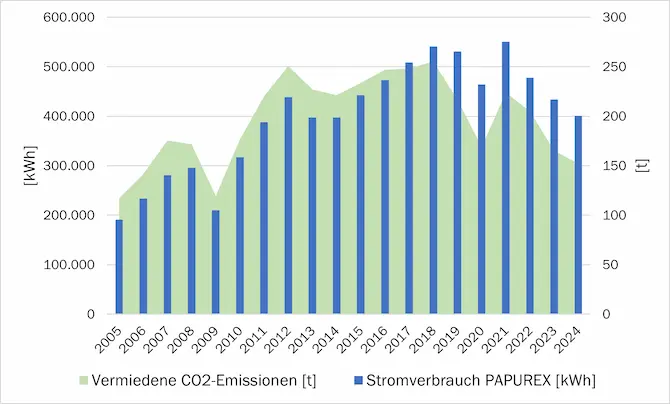
Pioneer in the implementation of the energy transition
In the first version of the environmental statement published in 2021, PAPUREX’s senior partner Rudolf Biebl set the goal of achieving CO2 neutrality in Scope 1 and Scope 2 by 2025. The terms of the scopes are explained in detail in the current version of our environmental statement, which can be downloaded in the Environment section. This goal has already been achieved for Scope 2 for several years, as PAPUREX has been purchasing exclusively green electricity since 2003. If the emissions that have been generated for the production of the average electricity mix in Germany per year since 2005 are offset against the use of green electricity during this period, PAPUREX has avoided almost 4,000 tons of CO2 emissions in the last 20 years alone.
In Scope 1, the oil heating system that supplies the production site in Klein-Breitenbach with heat was the last remaining major emitter. However, it has finally been decommissioned. Difficulties in procuring materials as a result of the recent crises and certain conditions at the production site had repeatedly delayed the start of the work. In December 2024, however, the time had finally come – the first work could be completed.

Investment in CO2-neutral production in Mörlenbach
The new heating system is a combination of two heat pump systems and is therefore extremely complex. The first part of the heat is provided by an air-to-water heat pump. This is probably the most widely used form of heat pump. In this type, the ambient air is used as an energy source via a fan. However, even though it is significantly larger and more powerful than the units used in private households, this alone is not sufficient to cover the heating requirements of PAPUREX’s entire business premises.
For this reason, a brine-to-water heat pump is also installed to support the air-to-water heat pump. This uses geothermal heat as an energy source instead of the ambient air. This system is more efficient than the air-to-water heat pump, particularly in very cold temperatures. Overall, the two heat pump systems not only support each other in providing sufficient heating energy but also complement each other in terms of their strengths.
The end of the old oil heating system

With the air-to-water heat pump, the first part of the system has already been put into operation. The second part of the system will be ready for use this spring. PAPUREX is therefore in a position to tackle the next heating period without the use of fossil fuels. In this way, the heat pumps will save between 7,000 and 8,000 liters of burnt heating oil per year, which corresponds to emissions of around 20 tons of CO2.
Further, more detailed information on heating conversion and all other environmentally relevant topics at PAPUREX can be found in our environmental statement. The third, updated edition of the document will be published this spring.
